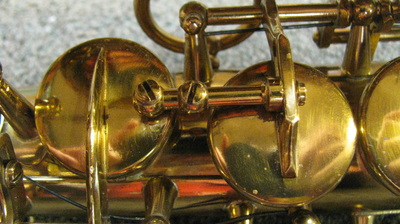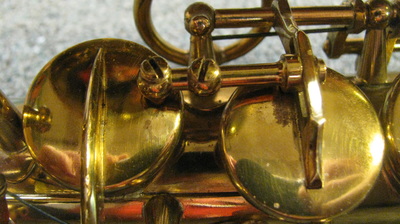Positioning Adjustable F#/G# Regulation Arm For Mechanical Advantage.
Compare the two photos here. On the left is the standard back to front positioning of the F#/G# adjustment arm on Selmer style systems. The arm is almost always as far forward as it can be in the slot on the F# key. On the right I have set it back for mechanical advantage.
In the picture on the left the G# adjustment screw has to hold down the G# key as close to the G# fulcrum as it can be. Meaning, in the back of the G# key cup. That gives the F# key, and its adjustment arm, the least mechanical advantage available.
Compare the two photos here. On the left is the standard back to front positioning of the F#/G# adjustment arm on Selmer style systems. The arm is almost always as far forward as it can be in the slot on the F# key. On the right I have set it back for mechanical advantage.
In the picture on the left the G# adjustment screw has to hold down the G# key as close to the G# fulcrum as it can be. Meaning, in the back of the G# key cup. That gives the F# key, and its adjustment arm, the least mechanical advantage available.
This is why door handles are positioned opposite the hinge side of the door. Imagine closing a door, but the handle is on the same side as the hinge.
When possible, as on Full Mechanical Overhauls or extensive Play Condition repairs on horns with this Selmer style system, I always reset the position of this arm so the adjustment screw is as far to the front of the G# key cup as possible. In other words, as far back in the slot on the F# key as possible.
If the adjustment screw is too close to the fulcrum, the G# key will sometimes flex when the left hand table is stroked. It will do this in spite of an otherwise perfect set up. This will create unusual and intermittent playability issues. At the least it will manifest itself as a hissing. At worst the horn will fail from C# - Bb.
The problem however is that this will happen even when the pad seats look perfect, and the G# key will show no light coming through during the mechanical test to check F#-G# regulation. It is this flexing that causes the leak. And moving the adjustment arm to the back of the F# key solves that problem. A common, and incorrect, solution is to over-regulate the F#-G# adjustment so the G# key is forced close out of necessity to close the F# key. No, no, no.
When possible, as on Full Mechanical Overhauls or extensive Play Condition repairs on horns with this Selmer style system, I always reset the position of this arm so the adjustment screw is as far to the front of the G# key cup as possible. In other words, as far back in the slot on the F# key as possible.
If the adjustment screw is too close to the fulcrum, the G# key will sometimes flex when the left hand table is stroked. It will do this in spite of an otherwise perfect set up. This will create unusual and intermittent playability issues. At the least it will manifest itself as a hissing. At worst the horn will fail from C# - Bb.
The problem however is that this will happen even when the pad seats look perfect, and the G# key will show no light coming through during the mechanical test to check F#-G# regulation. It is this flexing that causes the leak. And moving the adjustment arm to the back of the F# key solves that problem. A common, and incorrect, solution is to over-regulate the F#-G# adjustment so the G# key is forced close out of necessity to close the F# key. No, no, no.

